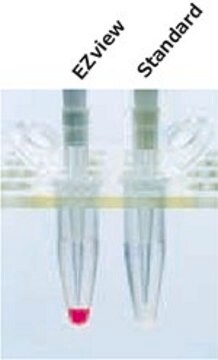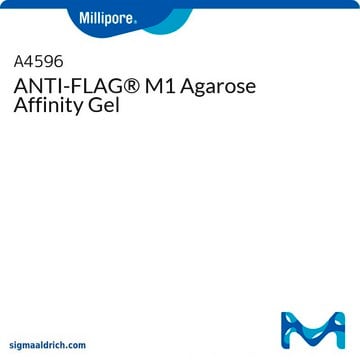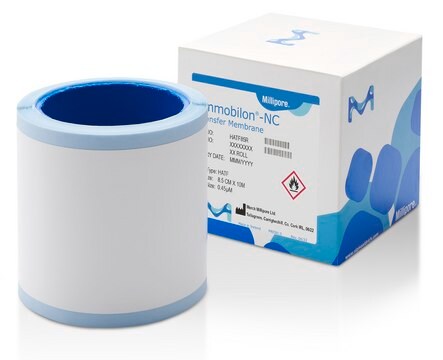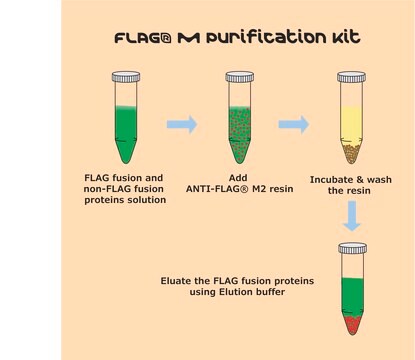11815024001
Roche
Anti-Protein C Affinity Matrix
from mouse IgG1κ
Sinonimo/i:
affinity matrix, anti-protein c
Autenticatiper visualizzare i prezzi riservati alla tua organizzazione & contrattuali
About This Item
Codice UNSPSC:
12352203
Prodotti consigliati
Origine biologica
mouse
Livello qualitativo
Coniugato
agarose conjugate
Forma dell’anticorpo
purified immunoglobulin
Clone
HPC4, monoclonal
Stato
slurry
Confezionamento
pkg of 1 mL (settled resin volume)
Produttore/marchio commerciale
Roche
Isotipo
IgG1, kappa
Capacità
2-10 nmol/mL binding capacity
Temperatura di conservazione
2-8°C
Categorie correlate
Descrizione generale
Protein C is a Vitamin K-dependent plasma zymogen that is activated by proteolytic cleavage of the thrombin-thrombomodulin complex to form an anticoagulant enzyme. Anti-Protein C mouse monoclonal antibody (clone HPC4) binds specifically to an epitope sequence spanning the thrombin cleavage site of protein C and is immobilized. Anti-Protein C recognizes the 12-amino acid sequence (EDQVDPRLIDGK), which encodes residues 6 through 17 of the heavy chain of Protein C. The formation of the Anti-Protein C/protein C epitope complex is dependent on the presence of calcium ions. In the presence of Ca2+, the antibody binds with high affinity and specificity to this sequence in native human Protein C or in proteins tagged with this epitope. This efficient binding within the recombinant fusion protein occurs regardless of the site of incorporation of the epitope tag (i.e., N terminus, C terminus, or within the reading frame). This unique antibody is especially well suited for purification of recombinant fusion proteins tagged with the protein C epitope.
Monoclonal mouse antibody Anti-Protein C (clone HPC4) is covalently coupled to agarose beads. In the coupling reaction 4mg of antibody is reacted per 1ml of beads.
- Insertion of the protein C tag does not introduce a new metal-ion binding site. The antibody contains the Ca2+ binding site.
- Protein C tag can be integrated either at the N-terminus, C-terminus or internally without any change in antibody specificity.
- Rapid immunoaffinity purification under non-denaturing conditions using economical calcium chelating agent (e.g., EDTA) or alternatively a specific protein C-tag peptide.
Monoclonal mouse antibody Anti-Protein C (clone HPC4) is covalently coupled to agarose beads. In the coupling reaction 4mg of antibody is reacted per 1ml of beads.
Specificità
Anti-Protein C recognizes the 12-amino acid sequence EDQVDPRLIDGK, which encodes residues 6 to 17 of the heavy chain of protein C. In the presence of Ca2, the antibody binds with high affinity and specificity to this sequence in native human protein C or in proteins tagged with this epitope. Efficient binding within the recombinant fusion protein occurs regardless of epitope position (N-terminal, C-terminal, or internal).
Applicazioni
Anti-Protein C Affinity Matrix is used for:
Following immunoprecipitation or purification, the tagged protein of interest may be analyzed by:
- Immunoprecipitation of Protein C-tagged proteins from mammalian, bacterial, and yeast cell extracts
- Affinity column purification of Protein C-tagged proteins from crude protein extracts
Following immunoprecipitation or purification, the tagged protein of interest may be analyzed by:
- Western blotting using the Anti-Protein C antibody
- Silver staining (or similar protein stain)
Caratteristiche e vantaggi
- use gentle elution conditions using calcium-chelating agents like EDTA.
- highly specific to EDQVDPRLIDGK, derived from protein C.
- binding of Anti-Protein C to protein C-epitop is dependent on the presence of calcium ions.
- suitable for purification of proteins containing protein C as N-terminal, C-terminal or internal fusion.
- applicable with crued cell extracts from mammalian, bacterial, and yeast expression systems.
Contents
1. The antibody is covalently coupled to agarose beads and supplied as a 2ml slurry containing 1ml beads and 1ml buffer.
2. 4mg of antibody is reacted per ml of beads in the coupling reaction.
3. A plastic column with top and bottom caps is included.
Confezionamento
1 kit containing settled resin and column
Qualità
Each lot of Anti-Protein C Affinity Matrix is tested for its ability to purify a Protein C-tagged protein expressed in transformed bacteria from crude bacterial extract. The antibody affinity column is used in combination with western blot and/or silver stain analysis.
Stato fisico
1 ml settled resin of Anti-Protein C Affinity Matrix in 20 mM Tris, 0.1 M NaCl, 1 mM CaCl2, and 0.09% sodium azide (w/v); 2 ml suspension equals to 1 ml bed volume. One plastic column with top and bottom caps is included
Risultati analitici
KD = 10–9 M Binding Capacity is 2 to 10 nmol/ml affinity matrix. Yield of 10.5 nmol purified protein/ml affinity matrix was determined using a whole-cell bacterial extract containing protein C-tagged β-galactosidase.
Altre note
For life science research only. Not for use in diagnostic procedures.
Codice della classe di stoccaggio
12 - Non Combustible Liquids
Classe di pericolosità dell'acqua (WGK)
WGK 1
Punto d’infiammabilità (°F)
does not flash
Punto d’infiammabilità (°C)
does not flash
Scegli una delle versioni più recenti:
Possiedi già questo prodotto?
I documenti relativi ai prodotti acquistati recentemente sono disponibili nell’Archivio dei documenti.
Mary Anne T Rubio et al.
Nature, 542(7642), 494-497 (2017-02-24)
Nucleic acids undergo naturally occurring chemical modifications. Over 100 different modifications have been described and every position in the purine and pyrimidine bases can be modified; often the sugar is also modified. Despite recent progress, the mechanism for the biosynthesis
Jing Huang et al.
Journal of molecular and cellular cardiology, 66, 157-164 (2013-11-26)
Despite advances in the treatment of acute tissue ischemia significant challenges remain in effective cytoprotection from ischemic cell death. It has been documented that injected stem cells, such as mesenchymal stem cells (MSCs), can confer protection to ischemic tissue through
Gabriela Schumann Burkard et al.
Molecular microbiology, 88(4), 827-840 (2013-04-27)
Different life-cycle stages of Trypanosoma brucei are characterized by stage-specific glycoprotein coats. GPEET procyclin, the major surface protein of early procyclic (insect midgut) forms, is transcribed in the nucleolus by RNA polymerase I as part of a polycistronic precursor that
Florian Bundis et al.
Cellular physiology and biochemistry : international journal of experimental cellular physiology, biochemistry, and pharmacology, 17(1-2), 1-12 (2006-03-18)
The weak inward rectifier potassium channel ROMK is important for water and salt reabsorption in the kidney. Here we identified Golgin-160 as a novel interacting partner of the ROMK channel. By using yeast two-hybrid assays and co-immunoprecipitations from transfected cells
J H Griffin et al.
The Journal of clinical investigation, 68(5), 1370-1373 (1981-11-01)
A family with a history of recurring thrombosis was studied to determine if a plasma protein deficiency could account for the observed disease. Protein C levels in plasma were determined immunologically using the Laurell rocket technique. The propositus, his father
Il team dei nostri ricercatori vanta grande esperienza in tutte le aree della ricerca quali Life Science, scienza dei materiali, sintesi chimica, cromatografia, discipline analitiche, ecc..
Contatta l'Assistenza Tecnica.








